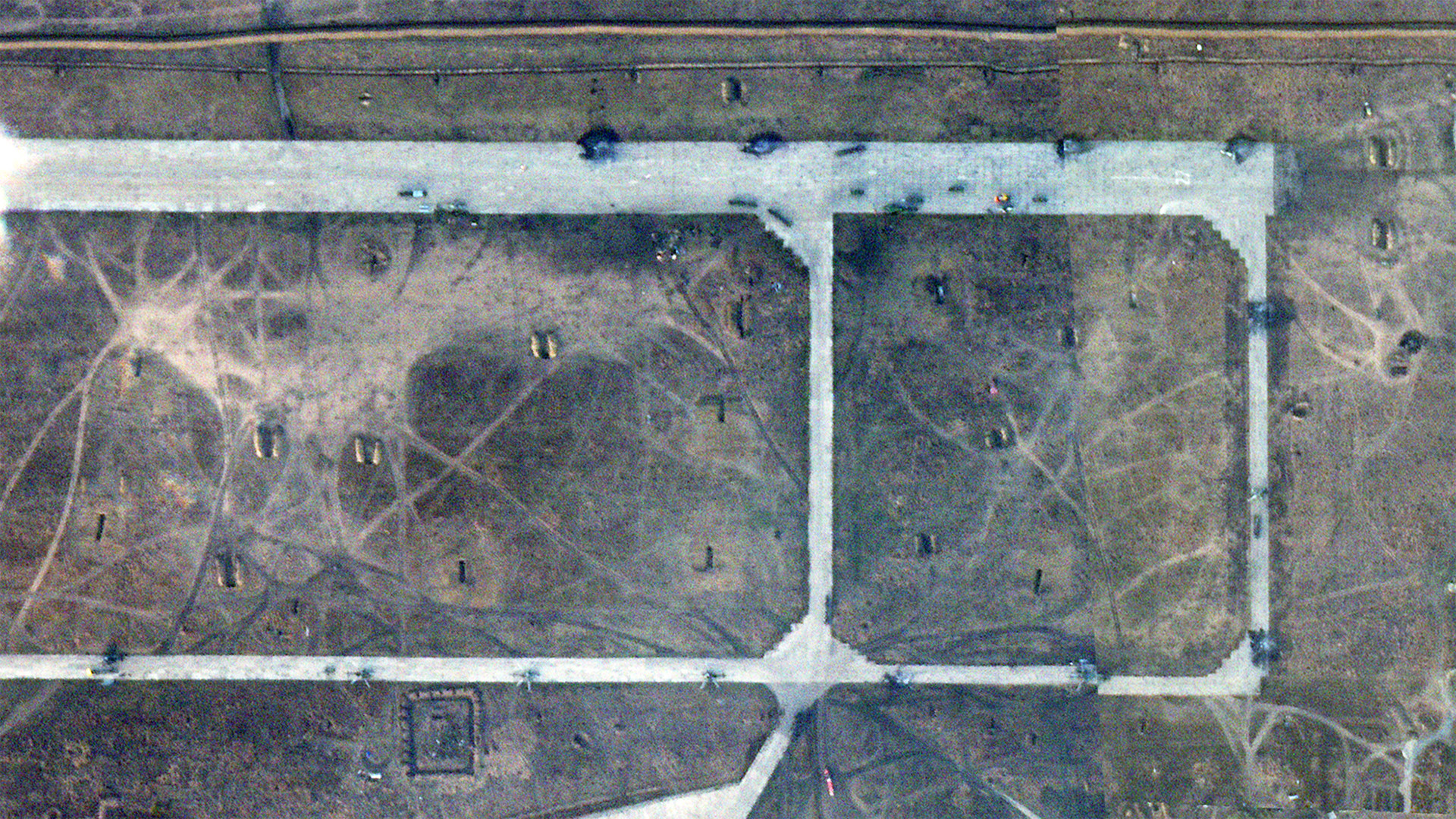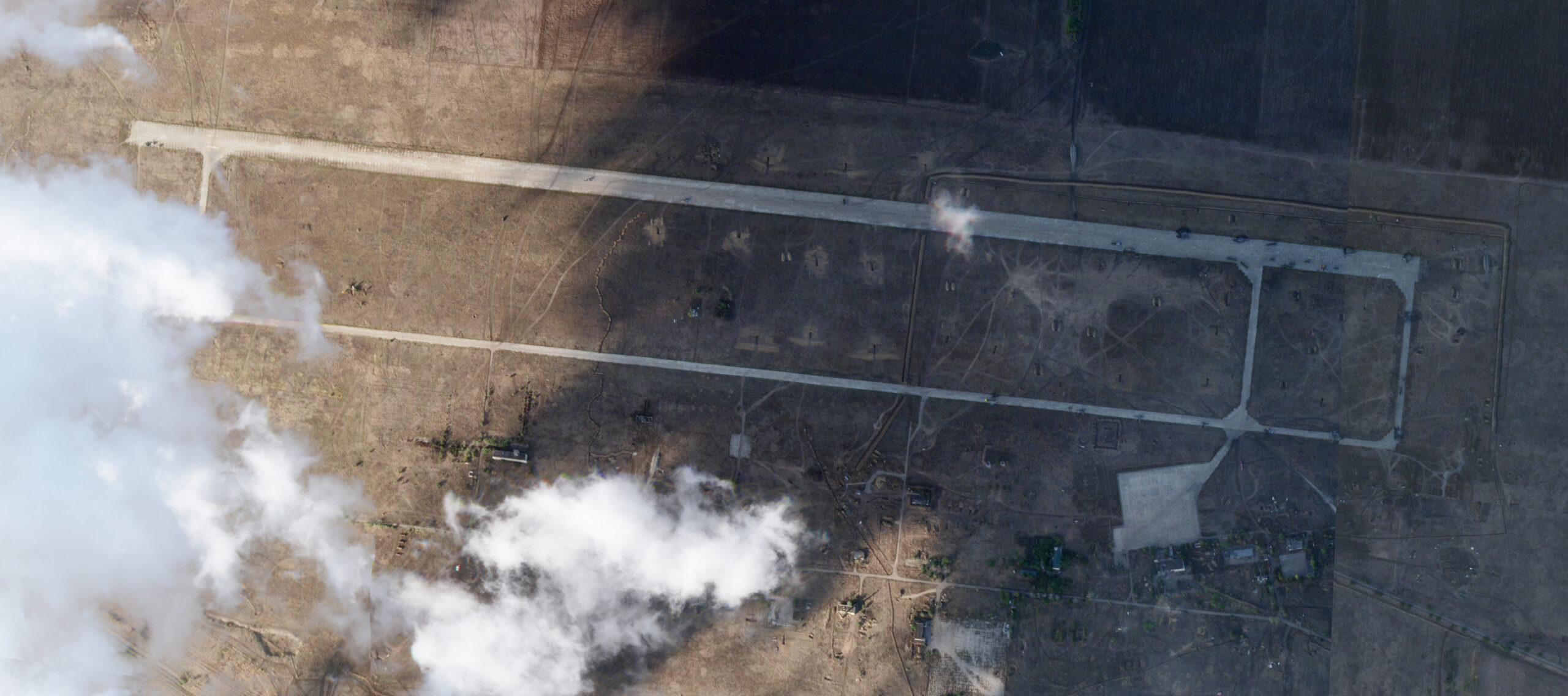The War Zone has obtained satellite imagery showing the aftermath of Ukraine’s first strikes using U.S.-supplied Army Tactical Missile System short-range ballistic missiles, or ATACMS, on the airport in the Russian-occupied city of Berdyansk yesterday. What can be seen looks to be broadly in line with the destruction Ukrainian officials said they had wrought on the facility using their newly delivered cluster munition-filled missiles. You can read more about what is already known about this strike in our initial reporting here.
Satellite imagery from Planet Labs taken earlier today shows at least nine distinct scorch marks, most with wreckage also visible, along the main runway and adjacent taxiways at the eastern end of Berdyansk airport. The locations of the scorch marks/wreckage are also consistent with where Russian helicopters are seen parked in earlier imagery in Planet Labs’ database.

At least three additional helicopters are seen parked along the long taxiway that runs parallel to the main runway, but it’s impossible to tell from the imagery whether or not they are also damaged in any way. There appears to be a significant amount of other activity along the eastern end of the main runway, which could reflect ongoing work to clear away damaged and destroyed helicopters and other debris.
Pictures have also already emerged of unexploded submunitions on the ground at Berdyansk. These will take at least some time to safely clear, and could in turn hamper efforts to get flight operations at the forward operating base up and running again at full capacity.
This facility has been in use as a Russian air base for months now. It is a known hub for helicopter operations in particular. What looks to be a mixture of Ka-52, Mi-24, and Mi-28 attack helicopters, as well as Mi-8/Mi-17 Hip transports (which can also be armed), have been observed there in past satellite imagery.
Ukrainian authorities claimed yesterday to have destroyed nine unspecified helicopters along with “special equipment that was located at airfields, [an] air defense launcher, [and] ammunition warehouse.”
An immediate analysis of the Planet Labs image from today does not readily show damage to any air defense systems or other “special equipment,” or large structures. However, cluster munitions like the ones inside the ATACMS missiles Ukraine has received, can easily cause significant damage or destroy their targets in ways that might not be easily visible via satellite imagery we have now. A radar dish shredded by shrapnel, for instance, would not necessarily be apparent at the available resolution.

So far, the ATACMS missiles that Ukraine has gotten are examples of the initial variant, known variously as the MGM-140A, the M39, and the Block I. These missiles have payloads consisting of 950 relatively small M74 submunitions. Though the area across which the submunitions are dispersed depends on release height and intended density dispersion, a stated typical profile for a single MGM-140A would see it rain its payload across a circular area some 677 feet in diameter, covering 360,000 square feet in total.
In terms of the M74 submunition, a 2002 paper from the Center for Army Lessons Learned describes its design and function thusly:
“The M74 grenade is filled with composition B explosive filler and is covered by a steel shell… Upon impact and detonation each grenade breaks up into a large number of high-velocity steel fragments that are effective against targets such as truck tires, missile rounds, thin-skinned vehicles, and radar antennas. This submunition is not effective against armored vehicles. The M74 grenade also contains incendiary material and has an antipersonnel radius of 15 m [just over 49 feet].”

As The War Zone previously explained in detail, airfields like the one Berdyansk, packed with ‘soft targets’ like helicopters, jets, and air defense systems out in the open, are exactly the kind of things that cluster munition-filled versions of ATACMS are ideally suited to strike. The satellite imagery from earlier today offers clear evidence of just how effective the strike on Berdyansk was thanks to the capabilities these missiles offer.
On top of that, MGM-140As, even though they have shorter ranges than later versions of ATACMS, just give the Ukrainian military additional capacity to strike at targets deeper inside Russian-occupied areas of the country. Based on the understood positions of the front lines now, Block I ATACMS are more than capable of hitting Russian forces in most parts of the country, including the northern part of the Crimean Peninsula.
Ukraine, of course, has various other options for hitting at Russian forces at extended distances inside occupied areas, as well as within Russia proper. At the same time, ATACMS, as ballistic missiles, come down on their targets at very high speeds and from very high altitudes. Cluster munition variants also break open well before they reach the ground, turning one big incoming threat into hundreds of smaller ones. This all makes them harder to defend against than other long-range strike options Ukraine has, including air and ground-launched subsonic cruise missiles and drones, all of which unitary warheads.
All told, the biggest implication for Russia is that the vast majority of air bases it operates from within Ukraine are now under direct threat from a highly effective and difficult-to-defend-against wide-area effect weapon. Russia has been making heavy use of forward-based airpower, and attack helicopters in particular, to limit Ukrainian gains in the course of its ongoing counter-offensive.
Forward-deployed Russian air defense assets, which also present significant threats to Ukraine’s own airpower, are now under significantly greater threat deep behind the front lines, too. Given what we’ve already seen at Berdyansk, it could force Russia to pull back various key assets to safer areas. This would drastically limit their potential contribution to the conflict. This is especially true for helicopters, which have limited range, and air defense systems that require varying proximity to potential targets to be effective.
Any soft skinned vehicle, large supply areas, or gatherings of personnel out in the open are equally threatened by the arrival of cluster munition-laden ATACMS. Achieving the same effects with standoff weapons equipped with unitary warheads would be resource draining, and those weapons are a precious one at that. And as we discussed earlier, those weapons are more vulnerable to intercept than ATACMs.
Exactly how many ATACMS missiles Ukraine has now, how many more examples it might be set to receive already, and whether other variants might be included in future deliveries, are unknown.
Regardless, as The War Zone predicted, the satellite imagery of Berdyansk airport makes clear that the appearance of the missiles in Ukrainian hands at all is a major problem for the Russian military that will force them to reassess how and where they operate within the country.
Contact the author: joe@thedrive.com
